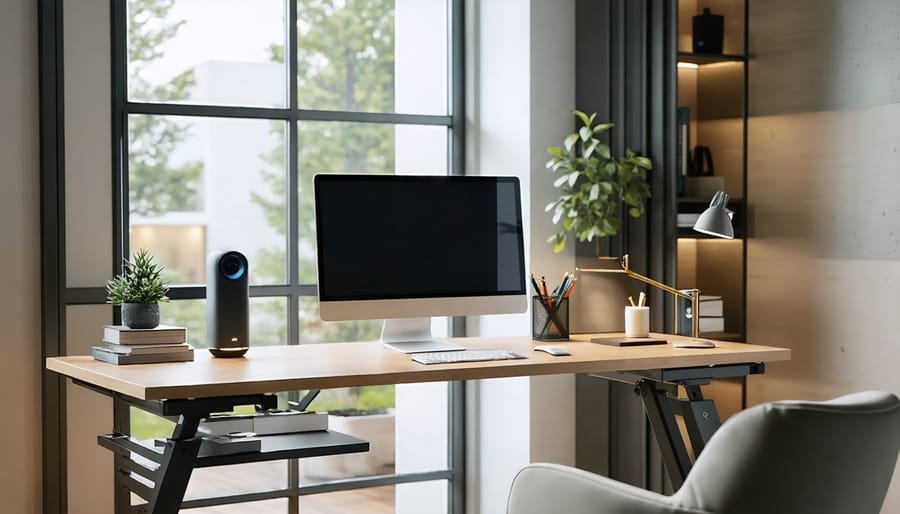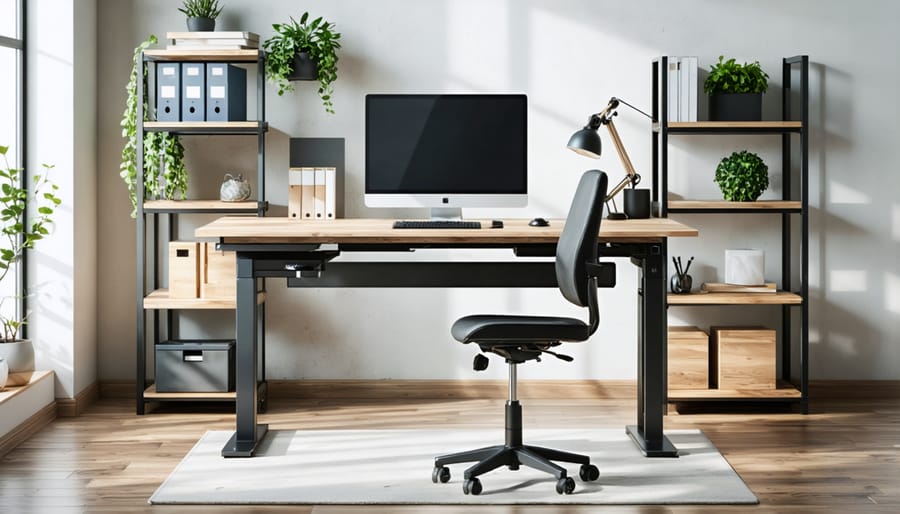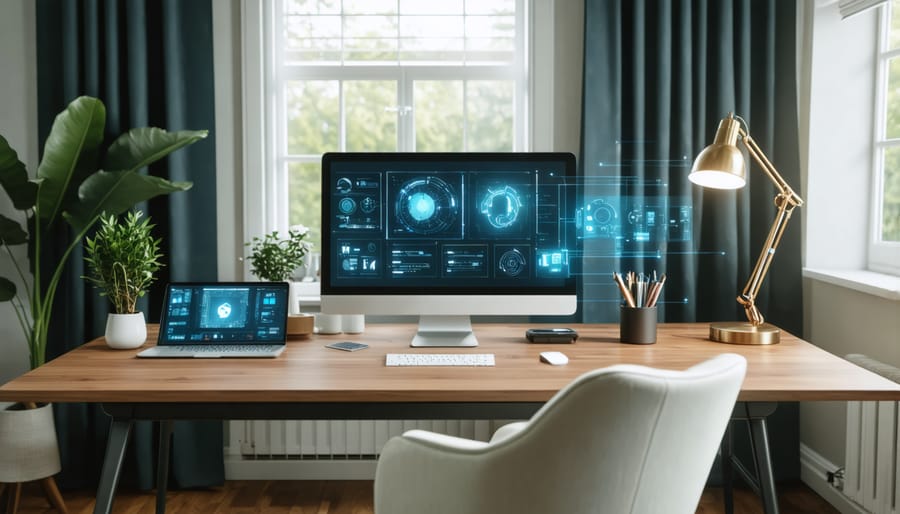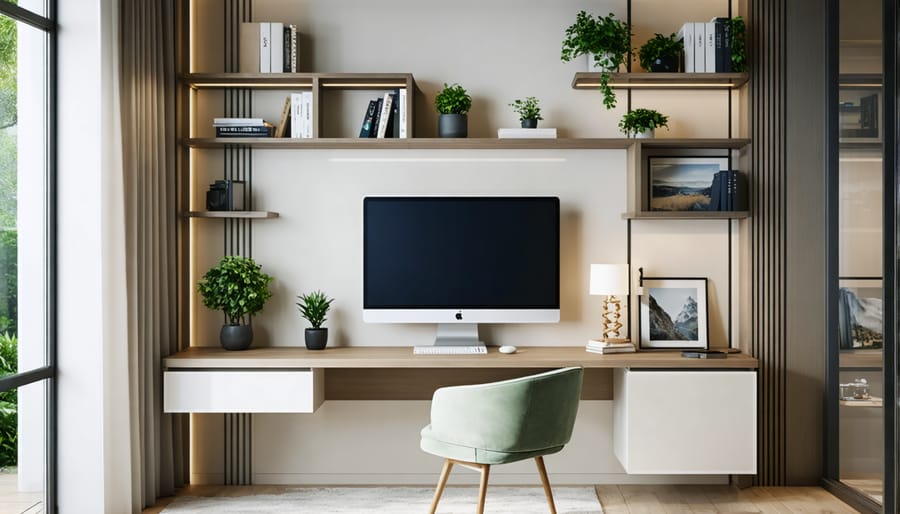
7 Smart Home Office Ideas That Boost Productivity and Style
Transform any room into a high-performing workspace by integrating smart technology, maximizing natural light, and creating dedicated zones for focused work. Modern home offices demand more than just a desk and chair—they require thoughtful design that can boost productivity in your home office while maintaining style and comfort. Position your desk perpendicular to windows to reduce screen glare while capitalizing on daylight, install programmable LED lighting that automatically adjusts throughout the day, and incorporate smart storage solutions with modular furniture that adapts to your evolving needs. Voice-controlled assistants, wireless charging stations, and cable management systems eliminate clutter while keeping essential technology within arm’s reach. Whether you’re converting a spare bedroom or carving out a corner of your living space, these smart office solutions seamlessly blend function with contemporary design to create a workspace that enhances both productivity and wellbeing.
Ergonomic Furniture Solutions

Adjustable Desks and Chairs
Investing in adjustable furniture is a game-changer for creating an ergonomic office setup that adapts to your needs throughout the day. Height-adjustable desks allow you to switch between sitting and standing positions, helping reduce the health risks associated with prolonged sitting. Look for models with smooth electric motors and preset height options for seamless transitions.
When selecting an ergonomic chair, prioritize features like adjustable lumbar support, armrests, and seat depth. A good chair should support your natural posture while allowing for micro-movements. Consider chairs with breathable mesh backs for comfort during long work sessions and those with multiple adjustment points to customize your seating position.
For budget-conscious homeowners, manual crank-operated standing desks offer a more affordable alternative to electric models. You can also explore desk converters that sit atop your existing desk, providing standing functionality without replacing your current furniture. Remember to pair any desk setup with an anti-fatigue mat when standing and ensure your monitor height aligns with your eye level for optimal comfort.
Storage and Organization
Smart storage solutions are essential for maintaining a clutter-free and productive home office environment. Start with vertical storage by installing floating shelves or wall-mounted cabinets to maximize your available space without sacrificing floor area. Consider modular storage systems that can grow with your needs and adapt to different configurations.
Under-desk storage solutions, like rolling file cabinets or compact drawer units, keep essential items within arm’s reach while maintaining a clean workspace. Look for desk organizers with built-in USB hubs and cable management features to keep your tech accessories tidy and accessible.
For a seamless look, opt for furniture pieces that double as storage, such as ottomans with hidden compartments or benches with built-in filing systems. Digital storage solutions, like cloud-based systems and network-attached storage (NAS) devices, can help reduce physical paper clutter while keeping your documents secure and accessible.
Don’t forget about cable management solutions – use cord clips, cable sleeves, or wire baskets mounted under your desk to keep cables organized and out of sight. This not only improves aesthetics but also makes cleaning and maintenance easier.
Smart Technology Integration

Smart Lighting Systems
Transforming your home office with smart lighting can dramatically improve both productivity and comfort. Today’s modern lighting solutions offer incredible flexibility and convenience through automation and smartphone control.
Start with smart LED bulbs in your main ceiling fixtures and desk lamps. These can be programmed to adjust their brightness and color temperature throughout the day, mimicking natural light patterns to help maintain your circadian rhythm. For example, cooler, brighter light in the morning can boost alertness, while warmer tones in the afternoon create a more relaxing atmosphere.
Motion sensors are game-changers for convenience and energy efficiency. Install them to automatically illuminate your workspace when you enter and turn off when you leave. For video calls, consider smart light strips behind your monitor or desk to create professional-looking lighting that eliminates harsh shadows.
Don’t forget about task lighting! Smart desk lamps with built-in presets for reading, writing, and computer work can help reduce eye strain. Many models even include voice control through Alexa or Google Assistant, letting you adjust your lighting hands-free during busy workdays.
For the best results, create different lighting scenes for various activities – “Focus Mode” with bright, cool lighting for intensive work, “Creative Mode” with medium warm lighting for brainstorming, and “Evening Mode” with dim, warm lighting for wrapping up your day.
Connected Devices and Automation
Transform your home office into a productivity powerhouse with smart devices and automation tools that streamline your workflow. Start with a smart assistant like Amazon Alexa or Google Home to control your office environment hands-free. These devices can manage lighting, temperature, and even start your coffee maker before you begin your workday.
Install smart plugs to automate your office equipment, allowing you to set schedules for devices to power on and off. This not only saves energy but ensures your workspace is ready when you need it. Smart lighting systems with motion sensors can automatically adjust brightness based on natural light and occupancy, reducing eye strain and maintaining optimal working conditions.
Consider a smart thermostat to maintain comfortable temperatures throughout your workday. Many models learn your preferences and adjust automatically, helping you stay focused and comfortable while keeping energy costs in check. For seamless connectivity, invest in a mesh Wi-Fi system to eliminate dead zones and ensure stable internet throughout your home office.
Voice-controlled smart blinds can help manage natural light without interrupting your workflow, while automated air purifiers maintain healthy air quality. Don’t forget about smart security features like cameras and door sensors, which provide peace of mind when working with sensitive materials.
The key to successful office automation is creating routines that match your work style. Start small with basic automation and gradually expand as you identify more opportunities to streamline your workspace.
Space-Saving Design Strategies
Multi-functional Furniture
When space is at a premium, multi-functional furniture becomes your secret weapon to maximize your small office space. Consider a fold-down desk that doubles as a wall-mounted picture frame when closed, or an ottoman that opens up to reveal file storage while serving as extra seating for clients. A sleek console table can transform into a full workspace with hidden compartments for office supplies and a pull-out keyboard tray.
Look for modular shelving systems that can be reconfigured as your needs change. A rolling filing cabinet can double as a printer stand and extra desk space when topped with a custom-cut piece of glass or wood. For those who occasionally need extra workspace, consider a Murphy-style desk that folds up against the wall, complete with built-in shelving and a corkboard interior.
Smart furniture choices might include a bookshelf that converts into a desk, or a credenza with a lift-top section for laptop use while standing. These versatile pieces not only save space but also maintain a clean, professional appearance when your office needs to double as a guest room or living space.
Vertical Space Utilization
When space is at a premium, thinking vertically can transform your home office into a productivity powerhouse. Start by installing floating shelves at different heights to create a dynamic storage solution that doesn’t eat up valuable floor space. These shelves can house everything from books and files to decorative items that inspire creativity.
Consider mounting a pegboard wall system, which offers incredible flexibility for organizing supplies and can be easily reconfigured as your needs change. Add hooks, small containers, and mini-shelves to create a customized storage solution that keeps everything within arm’s reach.
Wall-mounted monitor arms are another smart addition, freeing up desk space while allowing you to adjust your screen position throughout the day. Install a cable management system vertically along your wall to keep cords tidy and out of sight.
Don’t forget about the space behind your door – an over-the-door organizer can store office supplies, while wall-mounted file holders can keep important documents organized and accessible. For a touch of green without sacrificing space, try vertical garden planters that bring nature into your workspace while maintaining a clean footprint.
Remember to maintain visual balance by leaving some wall space empty to prevent the room from feeling cramped or cluttered.

Aesthetics and Comfort
Color Psychology
Color plays a vital role in creating a productive home office environment, directly impacting your mood, focus, and energy levels throughout the workday. For maximum productivity, consider incorporating blues and greens, which are known to enhance concentration and reduce eye strain. Blue promotes a sense of calm and stability, while green brings balance and harmony to your workspace.
If your job requires creativity, yellow can stimulate innovation and optimism, though it’s best used as an accent color to avoid overwhelming the space. For those seeking motivation and energy, strategic pops of red can help, but use it sparingly as too much can increase stress levels.
Neutral colors like white, beige, and gray create a professional backdrop and make your space feel larger. These colors also work well with natural light and provide a clean canvas for adding personality through colorful accessories. Consider painting one wall in a focus-enhancing color or incorporating your chosen hues through desk accessories, artwork, or chair cushions for a balanced, productivity-boosting environment that reflects your personal style.
Natural Elements
Bringing nature into your home office can significantly boost productivity and well-being. Start by incorporating a few low-maintenance plants like snake plants, pothos, or ZZ plants, which thrive in indoor environments and help purify the air. Position them near natural light sources or on floating shelves to maximize space while creating visual interest.
Consider using natural materials in your office furniture and decor. A solid wood desk adds warmth and character, while bamboo organizers and cork boards provide sustainable storage solutions. Natural fiber rugs, like jute or sisal, can define your workspace while adding texture and acoustic benefits.
Don’t forget about natural light – position your desk near a window when possible, but use light-filtering blinds to prevent glare on screens. If natural light is limited, consider full-spectrum LED lights that mimic daylight. Adding a small desktop water fountain or using essential oil diffusers with natural scents like lavender or eucalyptus can create a calming atmosphere that promotes focus and creativity.
Budget-Friendly DIY Solutions
Custom Built-ins
Custom built-ins can transform your home office from ordinary to extraordinary while maximizing storage and functionality. Here’s how to create your perfect storage solution in five manageable steps:
Start by measuring your space carefully, including wall heights, widths, and any architectural features like windows or outlets. Sketch your design on paper, considering both upper and lower cabinets, shelving configurations, and desk integration. Think about what you need to store – from files and office supplies to tech equipment.
Next, choose your materials. Pre-finished plywood offers a cost-effective option, while hardwoods provide a premium look. Purchase your chosen materials along with necessary hardware like drawer slides, hinges, and handles. Don’t forget to account for trim pieces that will give your built-ins a polished appearance.
Begin construction with the base cabinets, ensuring they’re level and properly secured to the wall. Install upper cabinets and shelving units, using a stud finder to guarantee sturdy mounting. Add custom touches like cable management holes, pullout keyboard trays, or hidden charging stations.
For the finishing touches, apply edge banding to exposed plywood edges, install trim pieces, and add your chosen hardware. Complete the look with a fresh coat of paint or stain that complements your home office design. Remember to seal any raw wood surfaces to ensure longevity.
Upcycling Projects
Transform your home office into a unique workspace by giving new life to existing items. That old ladder in your garage? Turn it into a stylish wall-mounted shelving system for documents and supplies. Got spare wooden crates? Stack and secure them to create modular storage units that add industrial charm to your office.
Consider converting an unused armoire into a compact workstation – when closed, it keeps your office hidden, perfect for multi-purpose rooms. Old mason jars make excellent organizers for pens, markers, and other desk supplies while adding a touch of vintage appeal.
Give that dated filing cabinet new purpose with a fresh coat of paint and decorative hardware. Transform it into a printer stand with built-in storage. Wine crates can become wall-mounted mail sorters, while old picture frames can be repurposed into bulletin boards with some cork backing and fabric.
Don’t overlook doors – an old door laid horizontally on filing cabinets creates a spacious desk with character. Metal pipes and reclaimed wood can form industrial-style shelving units. Even vintage suitcases can be stacked to create unique side tables with hidden storage compartments.
Remember, upcycling not only saves money but also adds personality and eco-friendly charm to your home office space.
Creating a smart home office doesn’t have to be overwhelming or expensive. By implementing even a few of these ideas, you can significantly enhance your workspace’s functionality and comfort. Start with the basics like proper lighting and ergonomic furniture, then gradually incorporate smart technology solutions that match your needs and budget. Remember that the key to a successful home office lies in finding the right balance between technology, comfort, and productivity.
Consider your specific work requirements and daily routines when choosing which smart solutions to implement first. Whether it’s installing automated blinds, setting up voice-controlled devices, or creating a custom lighting system, each upgrade can contribute to a more efficient and enjoyable work environment.
Don’t forget that your home office should reflect your personal style while maintaining professional functionality. Take time to plan your space carefully, and don’t hesitate to make adjustments as your needs evolve. With these smart office solutions in place, you’ll be well-equipped to tackle your work with improved focus, comfort, and productivity in your perfectly optimized home workspace.
